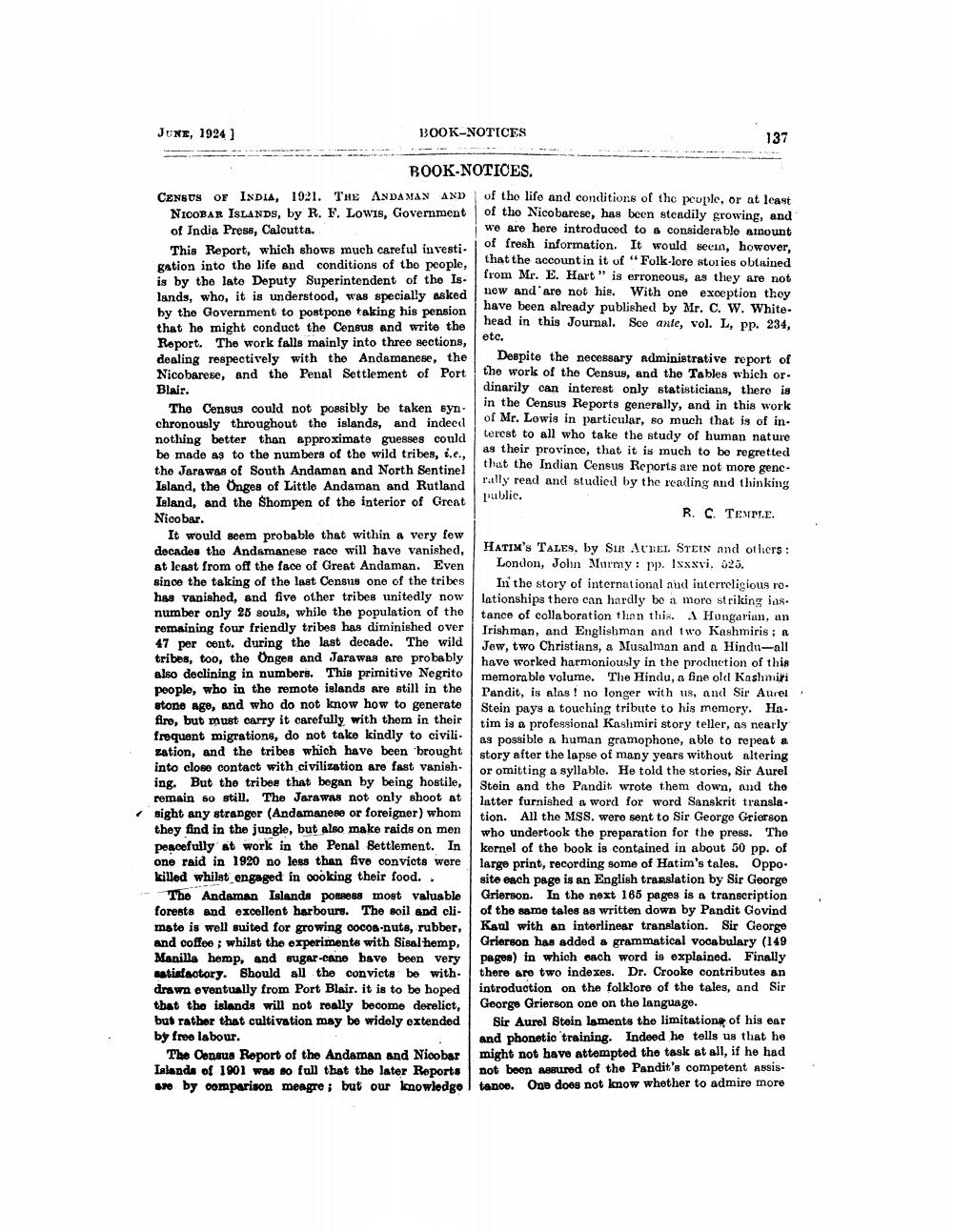________________
JUNE, 1924]
BOOK-NOTICES
BOOK-NOTICES.
CENSUS OF INDIA, 1921. THE ANDAMAN AND NICOBAR ISLANDS, by R. F. Lowis, Government of India Press, Calcutta.
This Report, which shows much careful investigation into the life and conditions of the people, is by the late Deputy Superintendent of the Is. lands, who, it is understood, was specially asked by the Government to postpone taking his pension that he might conduct the Census and write the Report. The work falls mainly into three sections, dealing respectively with the Andamanese, the Nicobarese, and the Penal Settlement of Port Blair.
The Census could not possibly be taken synchronously throughout the islands, and indeed nothing better than approximate guesses could be made as to the numbers of the wild tribes, i.e., the Jarawas of South Andaman and North Sentinel
Island, the Onges of Little Andaman and Rutland Island, and the Shompen of the interior of Great Nicobar.
It would seem probable that within a very few decades the Andamanese race will have vanished, at least from off the face of Great Andaman. Even since the taking of the last Census one of the tribes has vanished, and five other tribes unitedly now number only 25 souls, while the population of the remaining four friendly tribes has diminished over 47 per cent. during the last decade. The wild tribes, too, the Onges and Jarawas are probably also declining in numbers. This primitive Negrito people, who in the remote islands are still in the stone age, and who do not know how to generate fire, but must carry it carefully with them in their frequent migrations, do not take kindly to civili. zation, and the tribes which have been brought into close contact with civilization are fast vanishing. But the tribes that began by being hostile, remain so still. The Jarawas not only shoot at sight any stranger (Andamanese or foreigner) whom they find in the jungle, but also make raids on men peacefully at work in the Penal Settlement. In one raid in 1920 no less than five convicts were killed whilst engaged in cooking their food..
The Andaman Islands possess most valuable forests and excellent harbours. The soil and climate is well suited for growing cocoa-nuts, rubber, and coffee; whilst the experiments with Sisal hemp, Manilla hemp, and sugar-cane have been very satisfactory. Should all the convicts be withdrawn eventually from Port Blair. it is to be hoped that the islands will not really become derelict, but rather that cultivation may be widely extended by free labour.
The Census Report of the Andaman and Nicobar Islands of 1901 was so full that the later Reports are by comparison meagre; but our knowledge
137
of the life and conditions of the people, or at least of the Nicobarese, has been steadily growing, and we are here introduced to a considerable amount of fresh information. It would seein, however, that the account in it of "Folk-lore stories obtained from Mr. E. Hart" is erroneous, as they are not new and are not his. With one exception they have been already published by Mr. C. W. Whitehead in this Journal. See ante, vol. L, pp. 234,
etc.
Despite the necessary administrative report of the work of the Census, and the Tables which or dinarily can interest only statisticians, there is in the Census Reports generally, and in this work of Mr. Lowis in particular, so much that is of interest to all who take the study of human nature as their province, that it is much to be regretted that the Indian Census Reports are not more gencrally read and studied by the reading and thinking public.
R. C. TEMPLE.
HATIM'S TALES, by SIR AUREL STEIN and others: London, John Murmy: pp. 1xxxvi. 625.
In the story of international and interreligious ro lationships there can hardly be a more striking ias. tance of collaboration than this. A Hungarian, an Irishman, and Englishman and two Kashmiris; a Jew, two Christians, a Musalman and a Hindu-all have worked harmoniously in the production of this memorable volume. The Hindu, a fine old Kashmiri Pandit, is alas! no longer with us, and Sir Aurel Stein pays a touching tribute to his memory. Ha. tim is a professional Kashmiri story teller, as nearly as possible a human gramophone, able to repeat a story after the lapse of many years without altering or omitting a syllable. He told the stories, Sir Aurel Stein and the Pandit wrote them down, and the latter furnished a word for word Sanskrit transla. tion. All the MSS. were sent to Sir George Grierson who undertook the preparation for the press. The kernel of the book is contained in about 50 pp. of large print, recording some of Hatim's tales. Oppo site each page is an English translation by Sir George Grierson. In the next 165 pages is a transcription of the same tales as written down by Pandit Govind Kaul with an interlinear translation. Sir George Grierson has added a grammatical vocabulary (149 pages) in which each word is explained. Finally there are two indexes. Dr. Crooke contributes an introduction on the folklore of the tales, and Sir George Grierson one on the language.
Sir Aurel Stein laments the limitation of his ear and phonetic training. Indeed he tells us that he might not have attempted the task at all, if he had not been assured of the Pandit's competent assistance. One does not know whether to admire more




